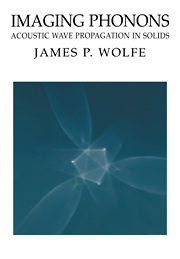Book contents
- Frontmatter
- Contents
- Preface
- Prologue – Anisotropic heat flow in crystals
- 1 Ballistic heat pulses and phonon imaging – A first look
- 2 Phonon focusing
- 3 Generation and detection of phonons – Experimental aspects
- 4 Focusing in cubic crystals
- 5 Acoustic symmetry and piezoelectricity
- 6 Lattice dynamics
- 7 Imaging of dispersive phonons
- 8 Phonon dynamics
- 9 Bulk scattering of phonons – Experiments
- 10 Quasidiffusion and the phonon source
- 11 Phonon scattering at interfaces
- 12 Refraction and reflection at solid/solid interfaces – Experiment
- 13 Imaging ultrasound in solids
- 14 Imaging surface acoustic waves
- 15 Interactions of ballistic phonons with electrons
- Appendix I Algebraic solution to the wave equation
- Appendix II Abbreviated tensor notation and group velocity
- Appendix III Survey of phonon focusing in cubic crystals
- Index
7 - Imaging of dispersive phonons
Published online by Cambridge University Press: 24 March 2010
- Frontmatter
- Contents
- Preface
- Prologue – Anisotropic heat flow in crystals
- 1 Ballistic heat pulses and phonon imaging – A first look
- 2 Phonon focusing
- 3 Generation and detection of phonons – Experimental aspects
- 4 Focusing in cubic crystals
- 5 Acoustic symmetry and piezoelectricity
- 6 Lattice dynamics
- 7 Imaging of dispersive phonons
- 8 Phonon dynamics
- 9 Bulk scattering of phonons – Experiments
- 10 Quasidiffusion and the phonon source
- 11 Phonon scattering at interfaces
- 12 Refraction and reflection at solid/solid interfaces – Experiment
- 13 Imaging ultrasound in solids
- 14 Imaging surface acoustic waves
- 15 Interactions of ballistic phonons with electrons
- Appendix I Algebraic solution to the wave equation
- Appendix II Abbreviated tensor notation and group velocity
- Appendix III Survey of phonon focusing in cubic crystals
- Index
Summary
The previous chapters have dealt mainly with phonon-focusing patterns that are independent of phonon frequency. This nondispersive behavior is expected when the wavelengths of the phonons are long compared to the spacing between atoms in the crystal. For phonons with wavelengths of only a few lattice spacings, large changes are expected in the slowness surface, group velocities, and focusing pattern. In practice, however, it is quite difficult to observe the ballistic propagation of such short wavelength (large-k) phonons. As their wavelength approaches twice the lattice constant (i.e., k ≡ 2π/λ approaches π/a), the phonons become particularly sensitive to defects in the periodicity in the crystal: they scatter.
The crystalline defects can be impurity atoms or even atoms with different isotopic masses. The fractional difference in mass between two isotopes is usually small, but many elements have more than one isotope of large natural abundance. This implies a high density of weak-scattering centers, even in chemically pure crystals. For long-wavelength phonons, the rate of mass-defect scattering increases as the fourth power of the phonon frequency, similar to Raleigh scattering of light from particles in the atmosphere. For example, the mean free paths of 1-THz phonons in otherwise perfect Ge, InSb, and GaAs are limited to a fraction of a millimeter by isotope scattering.
In order to observe the ballistic propagation of large-wavevector phonons in such crystals, the experimenter must use thin samples of high chemical and structural purity.
- Type
- Chapter
- Information
- Imaging PhononsAcoustic Wave Propagation in Solids, pp. 166 - 188Publisher: Cambridge University PressPrint publication year: 1998



